
Charlemagne was King of the Franks from 768, King of the Lombards from 774, and Emperor, of what is now known as the Carolingian Empire, from 800, holding these titles until his death in 814. He united most of Western and Central Europe and was the first recognised emperor to rule in the west after the fall of the Western Roman Empire, approximately three centuries earlier. Charlemagne's reign was marked by political and social changes that had lasting impact on Europe throughout the Middle Ages.

Pope Leo III was bishop of Rome and ruler of the Papal States from 26 December 795 to his death. Protected by Charlemagne from the supporters of his predecessor, Adrian I, Leo subsequently strengthened Charlemagne's position by crowning him emperor. The coronation was not approved by most people in Constantinople, although the Byzantines, occupied with their own defenses, were in no position to offer much opposition to it.

Year 774 (DCCLXXIV) was a common year starting on Saturday of the Julian calendar. The denomination 774 for this year has been used since the early medieval period, when the Anno Domini calendar era became the prevalent method in Europe for naming years.

Istria is a region of Croatia, and is the largest peninsula to border the Adriatic Sea. The peninsula is located at the head of the Adriatic between the Gulf of Trieste and the Kvarner Gulf, and is shared by three countries: Croatia, Slovenia, and Italy, 87% of its area being part of Croatia. Croatia encapsulates most of the Istrian peninsula within Istria County.
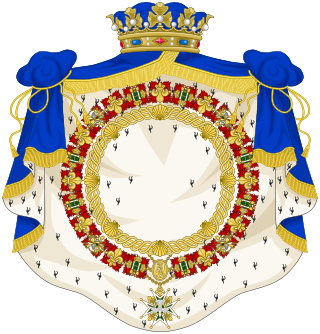
The Peerage of France was a hereditary distinction within the French nobility which appeared in 1180 during the Middle Ages.

Corvée is a form of unpaid forced labour that is intermittent in nature, lasting for limited periods of time, typically only a certain number of days' work each year. Statute labour is a corvée imposed by a state for the purposes of public works. As such it represents a form of levy (taxation). Unlike other forms of levy, such as a tithe, a corvée does not require the population to have land, crops or cash.

Under the French Ancien Régime, a parlement was a provincial appellate court of the Kingdom of France. In 1789, France had 13 parlements, the original and most important of which was the Parlement of Paris. Though both the modern French term parlement and the English word "parliament" derive from this French term, the Ancien Régime parlements were not legislative bodies and the modern and ancient terminology are not interchangeable.
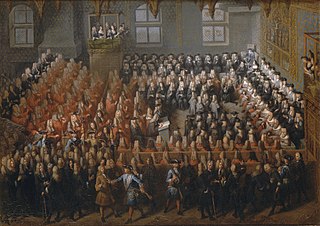
The Parlement of Paris was the oldest parlement in the Kingdom of France, formed in the 14th century. It was fixed in Paris by Philip IV of France in 1302. The Parlement of Paris would hold sessions inside the medieval royal palace on the Île de la Cité, nowadays still the site of the Paris Hall of Justice.

Maurizio Galbaio was the seventh traditional, but fifth historical, Doge of Venice from 764 to his death. He is considered to be the first great doge, who reigned for 22 years and set Venice on its path to independence and success.
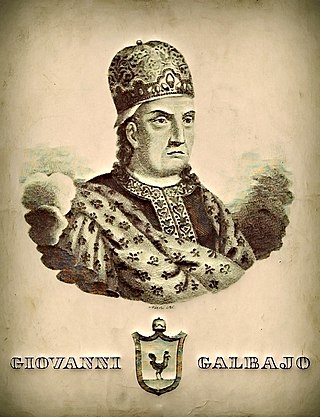
Giovanni Galbaio was the eighth Doge of Venice (787–804) according to tradition, but only the sixth historically verifiable one.
The Patrimony of Saint Peter originally designated the landed possessions and revenues of various kinds that belonged to the apostolic Holy See. Until the middle of the 8th century this consisted wholly of private property; later, it corresponded to the territories under Papal sovereignty, but from the early 13th century the term was applied to one of the four provinces of the States of the Church.

The Patriarchate of Aquileia was an episcopal see and ecclesiastical province in northeastern Italy, originally centered in the ancient city of Aquileia, situated near the northern coast of the Adriatic Sea. It emerged in the 4th century as a metropolitan province, with jurisdiction over the Italian region of Venetia et Histria. In the second half of the 6th century, metropolitan bishops of Aquileia started to use the patriarchal title. Their residence was moved to Grado in 568, after the Lombard conquest of Aquileia. In 606, an internal schism occurred, and since that time there were two rival lines of Aquileian patriarchs: one in New Aquileia (Grado) with jurisdiction over the Byzantine-controlled coastal regions, and the other in Old Aquileia. The first line (Grado) continued until 1451, while the second line continued until 1751. Patriarchs of the second line were also feudal lords of the Patriarchal State of Aquileia. A number of Aquileian church councils were held during the late antiquity and throughout the middle ages. Today, it is an titular archiepiscopal see.

Saint Paulinus II was a priest, theologian, poet, and one of the most eminent scholars of the Carolingian Renaissance. From 787 to his death, he was the Patriarch of Aquileia in what is now northeastern Italy. He participated in a number of synods which opposed Spanish Adoptionism and promoted both reforms and the adoption of the Filioque into the Nicene Creed. In addition, Paulinus arranged for the peaceful Christianisation of the Avars and the alpine Slavs in the territory of the Aquileian patriarchate. For this, he is also known as the apostle of the Slovenes.
Pax Nicephori, Latin for the "Peace of Nicephorus", is a term used to refer to both a peace treaty of 803, tentatively concluded between emperors Charlemagne, of the Frankish empire, and Nikephoros I, of the Byzantine empire, and the outcome of negotiations that took place between the same parties, but were concluded by successor emperors, between 811 and 814. The whole set of negotiations of the years 802–815 has also been referred to by this name. By its terms, after several years of diplomatic exchanges, the Byzantine emperor's representatives recognized the authority in the West of Charlemagne, and East and West negotiated their boundaries in the Adriatic Sea.

Andrea Antico was a music printer, editor, publisher and composer of the Renaissance born in the Republic of Venice, of Istrian birth, active in Rome and in Venice. He was the first printer of sacred music in Rome, and the earliest competitor of Venetian Ottaviano Petrucci, who is regarded as the first significant music printer.

The Marchof Carniola was a southeastern state of the Holy Roman Empire in the High Middle Ages, the predecessor of the Duchy of Carniola. It corresponded roughly to the central Carniolan region of present-day Slovenia. At the time of its creation, the march served as a frontier defense against the Kingdoms of Hungary and Croatia.
Hunfrid was the Margrave of Istria and, according to some sources, Duke of Friuli from 799 to c. 804, when a Duke John was ruling Istria. He was the founder of the family called the Hunfridings.
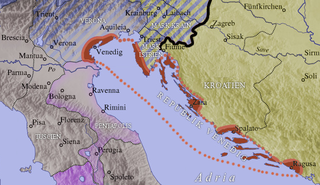
The March of Istria was originally a Carolingian frontier march covering the Istrian peninsula and surrounding territory conquered by Charlemagne's son Pepin of Italy in 789. After 1364, it was the Istrian province of the Habsburg monarchy, the Austrian Empire and Austria-Hungary.
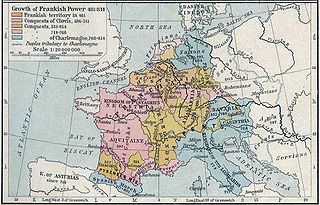
The siege of Trsat was a battle fought over possession of the town of Trsat in Liburnia, near the Croatian–Frankish border. The battle was fought in the autumn of 799 between the defending forces of Dalmatian Croatia under the leadership of Croatian duke Višeslav, and the invading Frankish army of the Carolingian Empire led by Eric of Friuli. The battle was a Croatian victory, and the Frankish commander Eric was killed during the siege.

Bürgher was a rank or title of a privileged citizen of a medieval to early modern European town. Burghers formed the pool from which city officials could be drawn, and their immediate families that formed the social class of the medieval bourgeoisie.